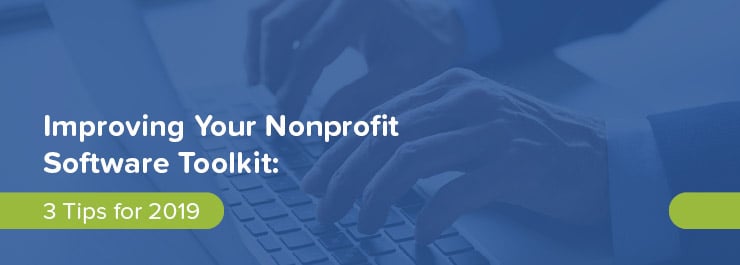
The start of a new year is the perfect opportunity for implementing new tech strategies, especially when it comes to fundraising. Even if your holiday giving campaigns exceeded your goals, you probably noticed a few gaps or blind spots in your strategies.
The relative peace and quiet of January, February, and March are the perfect time to take a quick pause and collect your thoughts. With your most recent major campaigns still fresh in your team’s memories, it’s time to look for ways to refine your fundraising strategies for 2019.
For many nonprofits, this often comes down to improving their software toolkits. Tight budgets mean organizations sometimes work with outdated tools far longer than they’d wish. However, learning not just how but why updated strategies can be so effective is the first step to finding new solutions that truly fit their needs.
Let’s walk through three of the most important things to keep in mind as you get started:

Focus on integrations.
Start by focusing on the foundation of all your fundraising and marketing strategies — your data. Your CRM or database platform should ideally be the starting point for any new software strategies you develop for the coming year.
Data-driven strategies are always preferable to shots in the dark, and using tools that speak the same language is a surefire way to ensure your team can make the most of all your nonprofit’s experiences over the past year. Which strategies really worked at engaging donors and raising funds? Which didn’t? Can you easily get back in touch with all the new donors you reached?
Using tools that integrate with your CRM can dramatically simplify day-to-day logistics for your team, but its biggest benefit is streamlining data management and analysis.
Donation apps that integrate with Salesforce are a good example. Not only do they help you easily build out the Salesforce framework, but they also ensure that the data generated by donation transactions can report cleanly to your database for storage and analysis. Check out the Soapbox Engage introduction to Salesforce donation apps to learn more.
Remember, if you’re looking to start improving your software toolkit, look first to your CRM and focus on tools that integrate with it.

Look for automated tools.
The logistics and labor-time required for proper data management can be overwhelming for smaller teams, especially when they have to rely on manual data entry or complicated reporting between separate platforms.
Automation should be at the top of your list of features to look for in new tools. The benefits of data automation really become clear when you work within an integrated set of tools that can draw from the same pool of data. Consider these examples:
-
Donation apps that automatically report transactions to your database for record-keeping purposes and for analyzing fundraising trends.
-
Event registration tools that cleanly report registrant contact information for use in planning and marketing the event.
-
Customizable online forms and surveys whose results can be automatically reported and matched to the appropriate contact profiles in your CRM.
Put simply, automated and integrated tools reduce the need for manual data management, giving you more time to identify trends and develop smarter strategies.
Again, Salesforce apps for nonprofits and tools that integrate with the platform are great examples, streamlining everything from donation tracking to auction management and making it easier to ensure no data or insights get lost between campaigns.

Refine your digital marketing strategies.
Most nonprofits already invest some time in digital marketing. The internet and social media have become central to our lives, so it’s practically a necessity.
However, many organizations don’t pay enough attention to fine-tuning their marketing strategies. Your mission is an extremely strong selling point for donors, but it’s not enough; you need data-driven strategies to guide your marketing, too.
The first few months of the year are the perfect time to reflect on your marketing successes and failures. Then, look at where your campaigns fell a little short and identify the tools or strategies that could’ve helped you more effectively reach your online audiences.
Think about the key performance indicators, or KPIs, that you typically use in your digital marketing campaigns. Some of the most useful KPIs include:
-
Total online donations
-
Online donor acquisition
-
Online donor retention
-
Email open and click-through rates
If you know that you need new digital marketing software, focus on your KPIs while researching your options. You’ll want to prioritize software that makes it easy to track and analyze engagement data, which is essential for refining your strategies in the future.
You might even discover that you don’t need new marketing tools but rather new data tools. Again, tools that integrate with your CRM platform are often the best choices. They make it easier to view and examine data in one place instead of relying on analytics platforms that don’t necessarily give you the whole picture of how your marketing affects your fundraising data.
Smarter data management can provide a major boost to your digital marketing techniques, from donor segmentation techniques to automated drip email campaigns. It’s more important than ever that you offer donors intuitive, mobile-friendly ways to engage with your mission, and pinpointing where your digital campaigns can improve is the only way to get started.
Sticking to your resolutions means more than just setting goals; you need to make plans for reaching them. If your organization wants to improve its software toolkit in 2019, focus on integrations and automation.
This is the best way to ensure that any new tools you find will actively help to strengthen your strategies and not just eat up your team’s time until the next year-end fundraising season.



COMMENTS